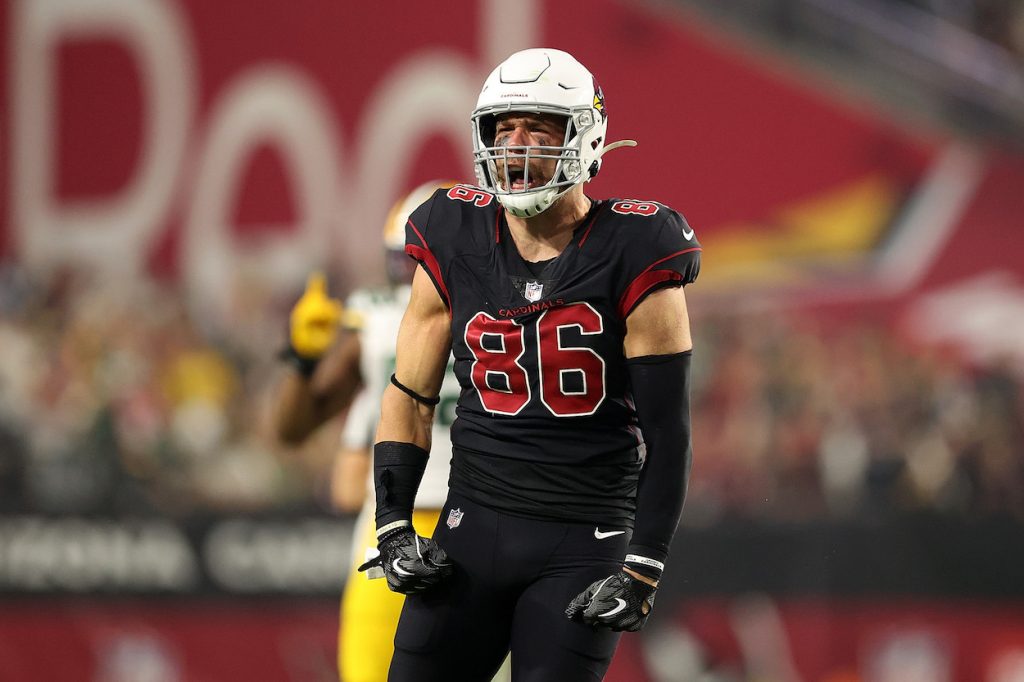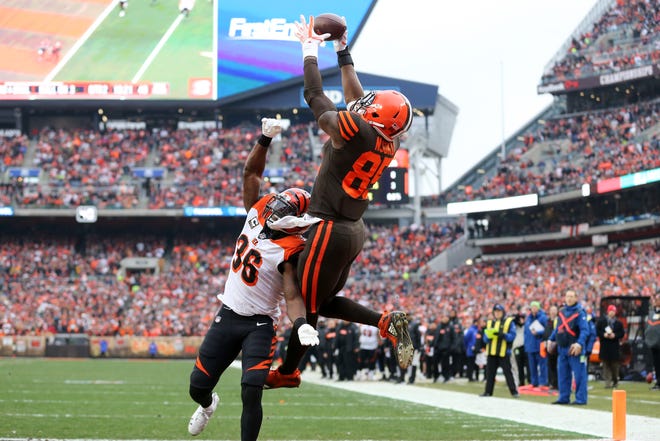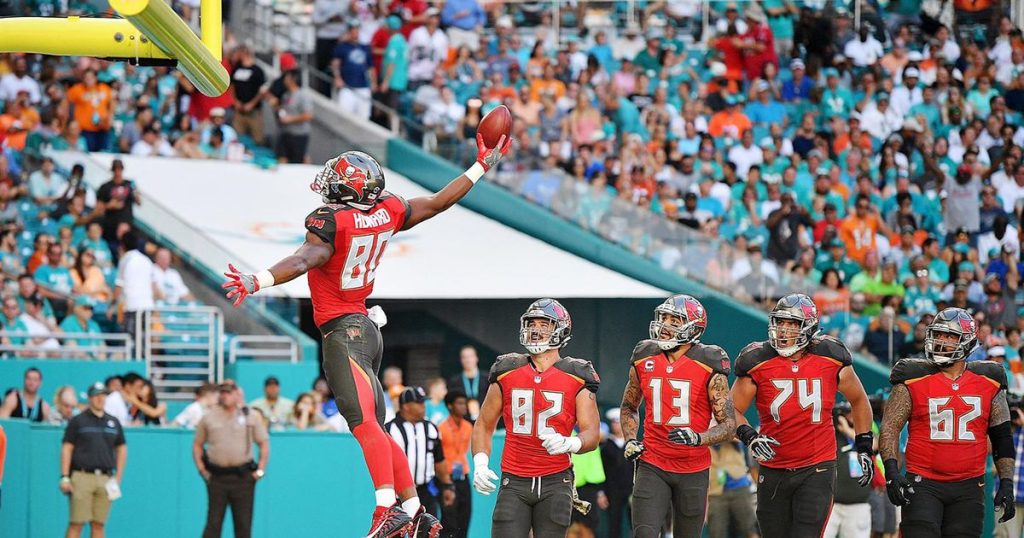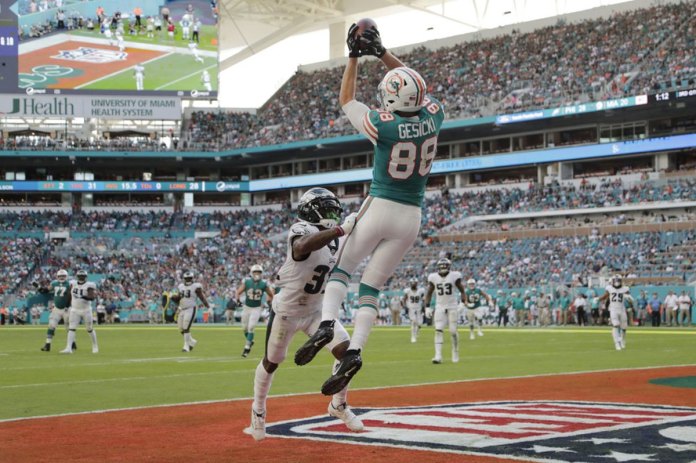One of the few things that the fantasy football industry has agreed over – okay, the only thing – is that there have been a few elite tight ends and then everybody else. After the top-tier players at the position, the talent pool falls off dramatically, leaving inconsistent point totals.
Well, that was fun while it lasted because now, we can’t even agree on that. In recent years, there’s been much more of a middle ground amongst tight ends. Guys like T.J. Hockenson, Dalton Schultz, Dallas Goedert, and others have fallen short of the elite group, for the most part, but have provided far more value than other names further down the list.
Part of this is due to the increase in two tight end leagues, but it’s also the nature of the position. Take Mike Gesicki, for example, who is featured on this list. After a slow start in his rookie season, he’s finished 12th, 7th, and 8th in PPR TE, scoring the last three years, respectively. A consistent pick to be the next breakout player at the position. Yet he has not made the leap into the elite tier but has still provided plenty of value in that middle tier.
Many on this list could still break into the top tier, but for many of these players, but for most, we hope they can live in that middle tier of TE scoring. A few of the other names on this list are former superstars nearing the end. Some of the others haven’t lived up to their high expectations as they entered the league.
Let’s take a deeper look at the group as we close out our free agent series, starting with the biggest names on the list.
Rob Gronkowski
Does the name get any bigger than Rob Gronkowski? Not at the tight end position, it doesn’t. It’s a matter of when, not if Gronk will wear a gold jacket. Most people also thought it was a matter of when, not if, he would retire after Tom Brady’s announcement to step away from the game. But as of today, he has not made that decision and will be a free agent if he decides to keep playing.
The four-time Super Bowl champion told TMZ on January 16th that he would retire if forced to decide at that moment. Although Gronk has said in the past that the only QB he would ever play with is Tom Brady, he made headlines a few weeks ago when he said that he would like to play with Joe Burrow. The bottom line is that nobody knows if he will hang up the cleats or not, but it’s fun to imagine him wearing stripes on his helmet and catches passes from one of the game’s new superstars.
He may not be the athlete he once was, but Gronk is still an extremely effective pass catcher. He finished as PPR’s TE7 while playing in just 12 games, including back-to-back 100-yard games, to finish the regular season. If he were to play his home games in Cincinnati next season, there’s no reason to think he can’t be a mid to low TE1.
He may not be the Wildcat he was coming out of the University of Arizona, but perhaps all these years later, he’s grown into his stripes as a Bengal.
Prediction: Rob Gronkowski signs a one-year contract with the Cincinnati Bengals.
Zach Ertz
Through his nine-year career, Zach Ertz has been as reliable as they come. In 2020, Ertz had a five-game stint on the IR due to a high ankle sprain, but outside of that season, he’s only missed six other games. He’s also never missed more than two games in a season outside of 2020. But it hasn’t just been his ability to stay on the field that’s been reliable.
If we remove the only season in which he’s missed significant time, 2020, you’d have to go back to 2016 to find a time when he finished outside of the top five in PPR TE scoring. Can you guess where he finished that season? TE6. He’s never finished lower than TE9, outside of 2020, of course.
Six weeks into the 2021 season, Ertz was sitting at TE15 in PPR scoring, and it appeared this Eagle’s production was finally taking a nosedive. After a mid-season trade sent him to the desert, he was able to spread his wings as a Cardinal, tallying 574 yards and three touchdowns the rest of the way. He would finish as PPR’s TE4 in weeks 7-18 and finished the season as TE5 overall.

Now, the only question is how many more flights this old bird has left. Spotrac projects Ertz’s market value at two years and $15.2 million, with a $7.6 million per year average. As much as the Cardinals would like to retain Ertz, they are in a tight situation with the salary cap, as I alluded to with regards to Christian Kirk. If the Cardinals don’t open up the checkbook for him, plenty of other suitors will. The Chargers and Colts are anticipating plenty of cap space, and both have a need at the position.
Although the Cardinals lack of cap space may keep them from adding a high-priced wide receiver, I believe they’ll ultimately find a way to keep their trade deadline acquisition around. Whether he’s playing his home games in Arizona or elsewhere, Ertz should continue his streak as a perennial TE1.
Prediction: Zach Ertz signs a two-year contract with the Arizona Cardinals.
Mike Gesicki
“I want to put him in my contract. You can’t poach him. I want him to be with me the rest of my career.” This is not a Mike Gesicki quote but rather a George Kittle quote. The connection? Mike McDaniel. Kittle expressed his appreciation for McDaniel, then the 49ers run-game coordinator, to the Mercury News in an interview leading up to Super Bowl LIV. The 49ers didn’t employ an Offensive Coordinator at the time, but McDaniel has long been Kyle Shanahan’s secret weapon, as he was Kittle’s. Now Miami’s head coach, he will become Gesicki’s secret weapon if the Dolphins can hang on to the impending free agent.
Gesicki checks all the boxes you could want in a receiving tight end prospect. He’s big, fast, and athletic. Despite the jaw-dropping measurables, he combined for just 772 yards and five touchdowns across his first two seasons. Then, in 2020, he got rolling with 703 yards and six touchdowns before posting 780 and two this past season. He finished as PPR’s TE11 and TE8 in those two seasons, respectively, but still has room to grow.

Mike McDaniel sure seems like the right guy to get that growth out of the former second-round pick. But what will the Dolphins have to pay to keep him around? That’s where things get complicated. Spotrac’s projected market value for Gesicki is $11 million per year, which would put him in the top 10 at the position. Considering his relative youth, skill level, and room to grow, that seems fair. But what happens if they don’t agree on a new contract? In that case, the team could slap him with the franchise tag and call it a day, right? After all, our friends over at Spotrac project the franchise tag for tight end’s to be $11 million.
Here’s the issue: the projected franchise tag for wide receivers sits at $18.5 million, a cool $7.5 million more than the tight end projection. If you recall, Jimmy Graham filed a grievance in 2014 stating that he should be designated as a wide receiver for this very same reason. Ian Hartitz of PFF breaks it all down, as he notes that Gesicki ran 92% of his routes from the slot or out wide. In other words, only 8% of his routes were different from a wide receiver. Hartitz also references rumors that Gesicki does indeed want to be characterized as a wide receiver.
It’s easy to assume that McDaniel and company would like to see Gesicki back with the Dolphins. But having yet to make good on his elite upside, it seems reasonable that the team would want to use the tag for a year to see how he fits into the new offense. That is if the tag is $11 million rather than $18.5 million.
Gesicki has a legitimate case to be classified as a wide receiver, but until that happens, I see this situation trending right towards a franchise tag. If he does stick with the fish, I like Gesicki as a mid TE1 with the upside to splash into the coveted top tier of tight ends.
Prediction: Mike Gesicki receives the franchise tag from the Miami Dolphins.
Dalton Schultz
After letting longtime Cowboy Jason Witten walk as a free agent in 2020, Dallas rewarded their young tight end with a contract extension, anticipating a breakout on the horizon. It would be a four-year, $22 million contract. The only problem – they extended the wrong tight end.
After going undrafted in 2017, Blake Jarwin found some success in 2018 and 2019 when he recorded back-to-back seasons over 300 yards, scoring three times each season. He became a trendy sleeper in the fantasy industry after receiving the extension in 2020 but would, unfortunately, go on to tear his ACL in the first game of the season. That’s where Dalton Schultz, the 2018 fifth-round selection, comes in. After catching just 13 passes for 122 yards and no touchdowns in his first two seasons combined, Schultz broke out with 615 yards and four touchdowns in 2020. Many speculated which WR would step up when Michael Gallup missed much of the 2021 season, but instead, it was Schultz who upped his game, catching 78 passes for 808 yards and eight touchdowns.
Schultz finished 2020 as PPR’s TE15 before shooting up to a TE5 finish in 2021, but it’s not just his receiving work that makes him so valuable. His run block win rate of 72.9% and pass block win rate of 93.2% prove that as Todd Archer of ESPN notes. Archer also points out that the team can save $4.25 million against the cap if they cut Jarwin.
The Cowboys have plenty of tough financial decisions to make this offseason but moving on from Jarwin seems like a no-brainer. The team obviously likes his athleticism. That’s why they extended him in the first place. It’s possible they see him as a cheaper option and let Schultz walk, but Schultz has provided more in the receiving game and is a superior blocker.
According to OverTheCap, the Cowboys are currently sitting at $22 million over the salary cap, so they will need to do some cutting and restructuring. Letting Jarwin go is a start, but they can also move on from Amari Cooper and save $16 million in the process. I expect them to restructure his contract and keep him around, which I also think they will do with Demarcus Lawrence. Restructuring each of those contracts can save them a significant amount of money. They can backload both of those deals to save money this season and still afford to resign Dalton Schultz and Randy Gregory.
The reality is that one of Schultz, Gregory, or Michael Gallup will likely be packing their bags. There are rumors that the team will prioritize Gregory and Gallup, but in my estimation, a tight end who excels as a blocker and is coming off a season with 808 yards and eight scores is more important to the team than their WR3. You can get nearly the same receiving production out of Schultz as you would Gallup, but he comes cheaper and plays a more pivotal role with the ability to play inline and block. The fact that the team can save money by cutting Jarwin is the cherry on top of the whole situation.
It would be a big mistake to prioritize Gallup, let Schultz walk, and count on Jarwin as the tight end replacement, in my opinion. With Jerry Jones in charge, however, it is certainly possible. It could be wishful thinking, but I’ll say the ‘Boys get this one right, and Schultz continues on his path as a TE1.
Prediction: Dalton Schultz receives the franchise tag from the Dallas Cowboys before eventually signing a long-term contract.
David Njoku
When we, as a human race, can finally figure out time travel, I challenge you to go back to 2017 and try to find a bigger David Njoku believer than myself. There are a few reasons why I’m comfortable making this assertion. One is that time travel is not happening. Sorry to burst your bubble. Another is the sheer athleticism and talent the former Hurricane possesses. I’m admittedly a sucker for big, athletic tight ends that resemble NBA power forwards. It’s far from a perfect science, but it’s also eye-popping when you see Travis Kelce as the best comparable on PlayerProfiler.
Many of the questions surrounding David Njoku as a prospect revolved around blocking. Although nobody will mistake him for George Kittle in that regard, Njoku has developed nicely as a blocker. Per PFF, he graded out as the 37th best run-blocking tight end and the 40th best pass-blocking tight end. Those spots are better than they sound on the surface, as many rotational tight ends are essentially a second tackle who is asked to do very little outside of block. His 64.1 run-blocking grade and 72.4 pass-blocking grade are right in the mix with starters who play nearly every down, so blocking is far from a limitation.
His receiving grade of 70 is the 25th best among tight ends, but Njoku excelled in efficiency this season. If you scroll past the Kelce comparison on his PlayerProfiler page, you will see that he averaged 13.2 yards per reception and 9 yards per target, good for fourth and fifth-best among tight ends, respectively. He sported the seventh-best QB rating per target at 121.2 and landed at sixth-best in fantasy points per target with 2.03. For reference, Davante Adams finished with 2.04 fantasy points per target, which came on over 100 more targets, but still.
Njoku has posted 1,754 receiving yards and 15 touchdowns through his five-year career thus far. I would have taken the over on each of those back in 2017, but in fairness, he missed 12 games in 2019. Outside of the 12 games missed in 2019, Njoku has been sidelined just four times across the other four seasons. However, he’s started just 36 games in his 65 games played. Sure, that can be criticized, but what were the Browns thinking when they signed Austin Hooper to a four-year, $44 million deal?
The lone season that Njoku was the primary starter, his second year in the NFL, he produced 639 yards and four touchdowns. He received 88 targets that season but has maxed out at 60 outside of 2018. The production hasn’t lived up to the hype or draft pick of 29th overall, but he will be just 26 this summer. It’s possible, if not likely, that his best football is still ahead of him.

During his season-ending zoom session, Njoku stated that he loves playing for the Browns and wants to play there for the rest of his career. Somewhat unfortunately, money is always a major influence in the decision. Spotrac projects his annual salary at $6.7 million, which the Browns can certainly afford. On the other hand, Sheil Kapadia of The Athletic points out that his production thus far is similar to Jonnu Smith’s, who inked a deal with the Patriots last year worth $12.5 million per year.
I was fully prepared to send Njoku to the Chargers in this hypothetical scenario and cash in on all the spots I have him rostered after waiting for this moment. Mary Kay Cabot of the Cleveland Plain Dealer has other thoughts, stating that the Browns not only want Njoku back, but they “are prepared to pay him the double-digit millions he’ll get on the open market.”
With that in mind, Njoku may be one of the few athletes who prefer staying in Cleveland over a move to Los Angeles (sorry, Cavs fans, but it’s been four years since LeBron left for LA). Baker Mayfield and the Browns don’t offer the same upside as Justin Herbert and the Chargers. Still, if Hooper is out the door, Njoku could flirt with TE1 status depending on the Browns offensive additions.
Prediction: David Njoku signs a long-term contract with the Cleveland Browns.
Evan Engram
Once considered a premier young talent at the tight end position, Engram has struggled to live up to expectations after posting 722 yards and six touchdowns in his rookie season, which landed him as 2017’s TE5. Tight ends are notoriously slow starters in the NFL, so it’s easy to see why so much was expected of the first-round pick after such a strong season to open his career.
The rib contusion that kept him out of the final game of his rookie season would act as a precursor to the next few years. Engram suffered a myriad of injuries, missing five games in 2018 and eight games in 2019. Due to the injuries and hefty expectations, it’s easy to overlook his production through his second and third seasons. In 2018, his 45 receptions, 577 yards, and three scores gave him 11.3 fantasy points per game, just .3 points shy of his rookie season average. The following season, Engram tallied 44 grabs for 467 yards and three touchdowns, but in just eight games, that would amount to 13.7 points per game. Extrapolating that over a full season would result in 88 catches, 934 yards, and six touchdowns. Unfortunately for Engram, it doesn’t quite work that way, but he was still producing at a high level when healthy.
Playing a full slate of games in 2020, Engram finished with 63 receptions for 654 yards and just one touchdown before suffering his worst season in 2021 with just 408 yards and three scores. So, where does his value stack up now? Spotract projects his market value at $6.7 million per year, but it truly is a guessing game with Engram. The Giants offense has been putrid recently, but he clearly presents tantalizing upside given his athletic traits and early success. It only takes one team to spend up, especially if that one envisions what Engram could be in the proper scheme.
I expect Engram’s deal to exceed the $6.7 million that Spotrac is projecting, especially when you consider that Ian Thomas just received a new deal worth $5.5 million per year. Tight end represents a need for many teams with cash to spend this offseason so that this market could heat up quickly.
Personally, I like Dan Arnold as a player, but with a new coaching staff who didn’t bring him in and the need to surround Trevor Lawrence with more weapons in the passing game, I would expect the Jaguars to take a long look at the tight end position. Plus, Doug Pederson utilized multiple tight ends in Philadelphia, and Engram can be used in the slot or out wide as much as any tight end.
Eight tight ends ran at least 75% of their routes from the slot or out wide in 2021 (min. 100 routes, PFF)
— Ian Hartitz (@Ihartitz) February 18, 2022
Mike Gesicki (92%)
Anthony Firkser (87%)
Kyle Pitts (80%)
Mark Andrews (79%)
Dan Arnold (78%)
Evan Engram (78%)
Logan Thomas (76%)
Juwan Johnson (76%)
Engram can’t be counted on as anything more than a TE2 at this point, but he could creep his way up near TE1 status in Jacksonville if a Trevor Lawrence breakout is on the horizon.
Prediction: Evan Engram signs a multi-year contract with the Jacksonville Jaguars.
Gerald Everett
The Seahawks have many questions that need to be answered this offseason. The most important one, obviously, revolves around the QB position and the future of Russell Wilson. There are many layers to that situation, and the ripple effect of a Wilson trade would be deep. Who would play QB? Would they remain competitive or rip the band-aid off and lean into a rebuild? The roster itself is much shorter on talent than the 12th man has grown accustomed to. With all of that and the fact that Seattle is without its first-round pick this April, you can see why rumors and speculation have followed D.K. Metcalf around this offseason.
The future of Wilson and Metcalf will undoubtedly play a factor in the team’s approach to the rest of its roster, including tight end, but they will need to make additions at the position regardless. Their top two tight ends last season, Gerald Everett and Will Dissly, are unrestricted free agents. While the team remains high on Colby Parkinson, he’s played in just 20 games across his first two seasons and has yet to catch more than two passes in any game.
Everett, who signed a one-year deal last offseason worth $6 million, produced career highs across the board with 48 receptions, 478 yards, and four touchdowns. Although he finished the season as just TE21, he will likely command a longer and potentially more lucrative contract this time around. After Russell Wilson returned to the lineup, from Week 10 forward, Everett averaged nearly four catches and 40 yards per game while scoring three times during that stretch.
The former second-round pick will be 28 next season, but it feels like there is another level to his game that has yet to be unlocked. He finished last season with a 98% true catch rate and a 71.4% contested catch rate, good for seventh and second amongst tight ends, respectively.
Although Everett hit his stride late in the season, and the Seahawks have over $35 million in cap space, much of that will be spent on the defensive side of the ball and a Metcalf extension. With Everett’s athleticism and flashes he showed down the stretch, he may see a better offer come from another franchise.
That’s where the Chargers come in, who have plenty of space, a need at the position, and a young QB who could benefit from the athleticism that Everett provides. As a fan of Everett as a prospect, I’ve always hoped a team was able to turn the key and unlock his potential. After a less explosive Jared Cook finished last season as PPR’s TE18 and TE15 in standard scoring, I would expect Everett to provide high-end TE2 numbers with TE1 upside in the Bolts offense.
Prediction: Gerald Everett signs a multi-year contract with the Los Angeles Chargers.
O.J. Howard
Coming out of Alabama, Howard was considered the cream of a loaded tight end crop in the 2017 NFL Draft. He was the first one off the board, going at pick 19 and four spots ahead of Evan Engram and ten picks before David Njoku. Gerald Everett was a second-round pick, Jonnu Smith a third, and George Kittle a fifth, with plenty of obscure names in between. I imagine there are just a few regrets with those selections ahead of Kittle.
Obviously, Howard has fallen short of the player that the Bucs, and many others, hoped he would become. That doesn’t mean he’s a bad player, however. The 11 touchdowns he scored across his first two seasons were positive, and his 1,456 receiving yards in his first three seasons playing in 36 games shouldn’t be dismissed.

He missed six games in 2018 with an ankle sprain and two games in 2019 with a hamstring strain but still managed to be productive. The train has since gone off the rails for Howard, who ruptured his Achilles tendon in 2020, missing 14 games. The injury, along with the Bucs addition of Rob Gronkowski, has limited Howard’s production the past two seasons, tallying just 281 yards and three scores during that stretch. He was able to stay on the field for 17 games in 2021 but saw limited action after ceding snaps to Cameron Brate, in addition to Gronk.
The former first-round pick should garner interest this offseason as he has mostly played well when active. Then again, tumbling down the Bucs depth chart to TE3 isn’t very reassuring. As I alluded to in part three of this series, Chris Ballard and Frank Reich’s seats are getting warm in Indianapolis, and they will be looking to make use of their sizeable amount of cap space.
With Jack Doyle providing some of the league’s best blocking from the tight end position, the team can afford to swing on a risky player with upside as a receiver. Mo Allie-Cox, a free agent, finished as PPR TE26, while Doyle landed at TE27. If Howard finds a consistent role in this offense, he should certainly be in the TE2 mix.
Prediction: O.J. Howard signs a short-term deal with the Indianapolis Colts.
CJ Uzomah
The Bengals tight end played a prominent role in the team’s march to the Super Bowl, posting career highs along the way. His 49 catches, 493 yards, and five touchdowns landed him at TE19 in PPR scoring for the season.
Coming off an average annual salary just north of $6 million, Uzomah should be in line for a raise after Ian Thomas set the market with his new deal, worth $5.5 million per year. In fact, Spotrac projects his market value at $8.2 million on a three-year deal.
The question is, are the Bengals willing to reach into their bag and shell that kind of money out to a former fifth-round pick, who coincidentally emerged with a career year when the Bengals offense took off? Was Uzomah a key cog in the Bengals offensive engine, or was he a beneficiary of an explosive offense providing him with slam dunk opportunities? I don’t have the answers to those questions, but for that type of money, I’d bet that Cincinnati can find similar production through the draft or spend up in free agency to get even more explosive at the position.
My prediction of the Bengals signing Gronk may be wishful thinking, as the NFL is a better product with Gronk spikes than without, but imagine what their offense could look like with a true game-changer at tight end. With apologies to C.J. Uzomah, he is not that kind of player. He is, however, a good player that can play every down. We saw him assist in the passing game, but he also featured a grade of 70.6 as a pass blocker, and 60 as a run blocker, per PFF. He would be a great fit on a roster that already has its foundation on offense, is watching its top three tight ends hit free agency, and needs someone who can block for the big guy in the backfield while pitching in on the passing game.
Uzomah would fit seamlessly with the Tennessee Titans offense, though his fantasy value could take a hit if that’s how it plays out. The Titans offensive engine is Derrick Henry, and they also feature two of the best wide receivers in the game, with A.J. Brown and Julio Jones. In this situation, and many others, Uzomah is best valued as a fringe TE2/3.
Prediction: C.J. Uzomah signs a multi-year contract with the Tennessee Titans.
Maxx Williams
Many will overlook Williams in a stout free-agent class of tight ends, but he was quietly putting together a breakout season before tearing his ACL in week five. Before the injury, he snagged 16 of his 17 targets for 193 yards and one score. That includes Week 1 when he saw just one target, the only target he didn’t catch, and Week 5, in which he went down on his first catch for 14 yards. In weeks 2-4, Williams tallied 15 receptions for 179 yards and his lone touchdown.
Obviously, this is a small sample size, but extrapolating that three-game stretch across a full 17 game slate would have him over 1,000 yards. Williams was PPR’s TE13 through the first four weeks, including the week one dud, but was TE5 in weeks 2-4. His 2.43 fantasy points per target topped Dawson Knox, who led the league among qualified candidates with 2.31.
Unfortunately for the former second-round pick, injuries have been a mainstay in his seven-year career. He’s suited up 72 times of a possible 113 games, and that doesn’t factor in the games he left early. The production as a pass-catcher hasn’t been consistent for Williams either. His best numbers came in his rookie season, 2015, with the Ravens when he posted 32 catches for 268 yards and one touchdown. Then again, he’s never received consistent targets. After seeing 48 passes thrown his way in 2015, he has yet to see more than 19 in any season since. In 2016, he didn’t receive a single target in four games.
Williams’ 6’4″, 252-pound frame allows him to excel as a blocker, which will be attractive to potential suitors. Per PFF, his run blocking grade has been 70 or higher in four straight seasons, a strong mark for a tight end. If he can stay healthy, his versatility will be a boon for a team like the New York Jets, who like to deploy tight ends who can block and need another pass catcher for Zack Wilson.
Jets tight ends coach Ron Middleton had high praise for the tight end group at the Senior Bowl, and with such a glaring need at the position, it seems likely that gang green will select one at some point. Pairing a rookie with Maxx Williams is a solid option and would keep Williams on the fantasy radar next season.
Prediction: Maxx Williams signs a multi-year contract with the New York Jets.
Beyond the names listed above, the tight end free agent crop features more depth than we’ve seen in a long time. A former first-round pick, Hayden Hurst, will provide a franchise with a secondary receiving option at tight end and above-average blocking abilities. Rumor has it, he could be in store for a return to Baltimore. Ricky Seals-Jones has spent plenty of time on the injury report but has been a quality receiver when he suits up. He could be an option for a team looking for another receiving option, like the Green Bay Packers, who could lose Robert Tonyan as a free agent. Mo Alie-Cox is perhaps the best blocking tight end of the bunch and will be targeted by teams who prioritize that. There are also multiple veteran guys who are not the sexy names they once were but can still provide depth and receiving, like Jimmy Graham, Eric Ebron, and Jared Cook.
It’s a good time in the NFL to need at tight end and a good time for you to invest in affordable free-agent tight ends who could land in a fruitful situation.
Get ready for your rookie draft with the DynastyGM!! Rankins, trade calculator, league analyzer, and much more. Just $4.99/month or better yet, bundle with the Nerd Herd for just $6.99/month and get extra podcasts, the Dynasty Prospect Film Room, and more.








